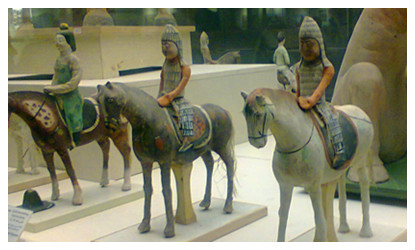Skype: neodalle-travel
Tel: +86 135 7447 2266
E-mail: sales@visitaroundchina.com
 Until the Han Dynasty (206 BC-24 AD), the government stationed troops there to reclaim wasteland near to the city in order to ensure security for the Silk Road. In the Eastern-Han Dynasty, Urumqi was one part of the Wei-Jin Dynasties and the Sixteen Kingdoms. In the early Western Han Dynasty, the government stationed a garrison commander at Jinman (Jimsar), made an encampment here and opened up wasteland for cultivation to ensure farming and to guarantee the security of the northern part of the Silk Road.
Until the Han Dynasty (206 BC-24 AD), the government stationed troops there to reclaim wasteland near to the city in order to ensure security for the Silk Road. In the Eastern-Han Dynasty, Urumqi was one part of the Wei-Jin Dynasties and the Sixteen Kingdoms. In the early Western Han Dynasty, the government stationed a garrison commander at Jinman (Jimsar), made an encampment here and opened up wasteland for cultivation to ensure farming and to guarantee the security of the northern part of the Silk Road.
In the year 640, the government of the Tang Dynasty established Tingzhou Prefecture which had jurisdiction over four counties. The area was named Luntai County. It was once a military stronghold for the Tang Dynasty to defend against their enemy. The Ancient City Site at the northern part of the Wulabo Reservoir in the south suburb of modern-day Urumqi is the site of ancient Luntai County and it was the most important military town of the period. The frontier poet, Cen Seng, lived in Luntai County for about three years, and he composed the famous verse comprising of the lines “Looked from the garrison tower, the smoke signal of the military warning was sent out; the troops of the Han Dynasty are massed to the north of Luntai County.”
The city's fortunes began to rise in the middle of the Qing Dynasty (1644-1911).In the 23rd year of Qian Long (1758), the troops built an earth city outside the South Gate, which was the origin of the walled city of Urumqi.The first step of the city's building project was taken in 1758. Later, in the 28th year of Qian Long (1763), the earth city was extended to the north. It was named Dihua upon completion. In the 10th year of Guang Xu in the Qing Dynasty (1884), Xinjiang was established as a province, and the Qing government relocated the military and administrative center originally set up in Xinjiang from Ili to Dihua; thus, Dihua became the capital of Xinjiang Province.
In 1949, Xinjiang was liberated peacefully, and the people’s government of Dihua City was established. On Feb. 1st, 1954, Dihua reverted to its original name of Urumqi. Nowadays, Urumqi, boasting a history of more than 1,000 years, is a thriving, modern metropolis.
Nowadays, as the capital city of the Xinjiang Uygur Autonomous Region, Urumqi includes five districts and the Urumqi County. Because of its particular position, it is a transportation hub for linking the south and north area of the Tianshan Mountains as well as connecting Xinjiang and central China.
 Ask Questions ?
Ask Questions ?